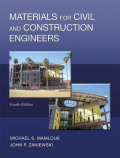
EBK MATERIALS FOR CIVIL AND CONSTRUCTIO
4th Edition
ISBN: 8220102719569
Author: ZANIEWSKI
Publisher: PEARSON
expand_more
expand_more
format_list_bulleted
Question
Chapter 11, Problem 11.7QP
To determine
Name three functions of the matrix phase in fiber-reinforced composites and state the reason for the need for a strong bond between the fibers and the matrix.
Expert Solution & Answer
Want to see the full answer?
Check out a sample textbook solution
Students have asked these similar questions
Name three functions of the matrix phase in fiber-reinforced composites.State the reason for the need for a strong bond between the fibers and the matrix.
Explain
A steel bar and an aluminum bar are bonded together as shown to form a composite beam. Knowing that the vertical shear in the beam is 4 kips and that the modulus of elasticity is 29 * 106 psi for the steel and 10.6 *106 psi for the aluminum, determine (a) the aver-age shearing stress at the bonded surface, (b) the maximum shearing stress in the beam.
Chapter 11 Solutions
EBK MATERIALS FOR CIVIL AND CONSTRUCTIO
Ch. 11 - Prob. 11.1QPCh. 11 - Prob. 11.2QPCh. 11 - Prob. 11.3QPCh. 11 - Prob. 11.4QPCh. 11 - Prob. 11.5QPCh. 11 - Prob. 11.6QPCh. 11 - Prob. 11.7QPCh. 11 - Prob. 11.8QPCh. 11 - Prob. 11.9QPCh. 11 - What are the functions of aggregate used in...
Ch. 11 - Prob. 11.11QPCh. 11 - Prob. 11.12QPCh. 11 - What are the benefits of adding dispersed steel...Ch. 11 - Getting measurements from Figure 11.20, determine...Ch. 11 - Three 6 in. 12 in. concrete cylinders with...Ch. 11 - Prob. 11.16QPCh. 11 - Prob. 11.17QPCh. 11 - Prob. 11.18QPCh. 11 - Prob. 11.19QPCh. 11 - Prob. 11.20QPCh. 11 - Prob. 11.21QPCh. 11 - Prob. 11.22QPCh. 11 - Prob. 11.23QPCh. 11 - Prob. 11.24QPCh. 11 - Prob. 11.25QPCh. 11 - Prob. 11.26QPCh. 11 - Prob. 11.27QPCh. 11 - Prob. 11.28QPCh. 11 - Prob. 11.29QPCh. 11 - Prob. 11.30QPCh. 11 - A circular FRP composite rod with continuous and...
Knowledge Booster
Similar questions
- Q2: A composite beam is made of two brass [E =100 GPa] plates bonded to an aluminum [E =75 GPa] bar, as shown in Figure below. The beam is subjected to a bending moment of 1200 N-m acting about the z axis. Determine: (a)the maximum bending stresses in the brass plates and the aluminum bar. (b) the stress in the brass at the joints where the two materials are bonded together.arrow_forwardThe following are functions of a matrix, EXCEPT: Subjects the fibers, which carry most of the load, to stresses Reduces the propagation of cracks in the composíte O Subjects the fibers from physical damage and the environmentarrow_forwardWhen looking up data for composite materials, it is important to: a.)Make sure the volume fraction of the fibres is specified b.)The orientation of each fibre layer is specified c.)The type of resin/matric is specified d.)All of the abovearrow_forward
- IV- It is necessary to design a continuous and aligned glass fiber-reinforced polyester having a tensile strength of at least 1400 MPa in the longitudinal direction. The maximum possible specific gravity is 1.65. Using the following data, determine whether such a composite is possible. Justify. Assume a value of 15 MPa for the stress on the matrix when the fibers fail. Material Glass fiber Polyester Specific gravity 2.5 1.35 Tensile strength (MPa) 3500 50arrow_forwardA 1500 mm long composite bar consists of aluminum and steel as shown. The cross-sectional area of the aluminum bar is twice that of the steel bar. If the assembly is exposed to an axial tensile load of 250 kN, determine the lengths of each of the components if the elongation of the aluminum is the same with that of the steel. The modulus of elasticity of steel E = 200 GPa and for the aluminum is one-third of the steel.arrow_forwardList three composite materials that make advantage of covalent and ionic bonding. Each material has three materials.arrow_forward
- 1. Three metal strips, each 40 mm height, are bonded together to form the composite beam shown. The modulus of elasticity is 210 GPa for the steel, 105 GPa for the brass, and 70 GPa for the aluminium. If the allowable bending stress for the aluminum (Gallow)al= 100 MPa, for the steel (Gallow)s=150 MPa and (Gallow)b= 200 MPa for brass determine the maximum allowable intensit of w of the uniform distributed load. 2w Aluminum 2w 10 mm Brass 10 mm Steel 20 mm 2m - 40 mmarrow_forward1. Three metal strips, each 40 mm height, are bonded together to form the composite beam shown. The modulus of elasticity is 210 GPa for the steel, 105 GPa for the brass, and 70 GPa for the aluminium. If the allowable bending stress for the aluminum (Gallow)al= 100 MPa, for the steel (Gallow)st 150 MPa and (Gallow)br=200 MPa for brass determine the maximum allowable intensit of w of the uniform distributed load. 2w 2m Aluminum Brass Steel 40 mm- 10 mm 10 mm 20 mmarrow_forwardA bar having the cross section shown has been formed by securely bonding brass and aluminum stock. Taking h= 9 mm and using the data given below, determine the largest permissible bending moment when the composite bar is bent about a horizontal axis. Brass Aluminum 30 mm Modulus of elasticity Allowable stress h 30 mm h Aluminum 70 GPa 100 MPa The largest permissible bending moment is Brass 105 GPa 160 MPa 1.17 kN-m.arrow_forward
- 3 For a composite bar as shown below, what is the relation between axial deformation and thermal deformations in the bar? Cu tube (1) Steel bar (2) D d- Where, o,, o, = stresses in Cu and steel bar respectively. Coefficient of thermal expansion for Cu and steel bar respectively.arrow_forwardPlease resolve the questionarrow_forwardGive me right solution according to the questionarrow_forward
arrow_back_ios
SEE MORE QUESTIONS
arrow_forward_ios
Recommended textbooks for you
 Materials Science And Engineering PropertiesCivil EngineeringISBN:9781111988609Author:Charles GilmorePublisher:Cengage Learning
Materials Science And Engineering PropertiesCivil EngineeringISBN:9781111988609Author:Charles GilmorePublisher:Cengage Learning

Materials Science And Engineering Properties
Civil Engineering
ISBN:9781111988609
Author:Charles Gilmore
Publisher:Cengage Learning